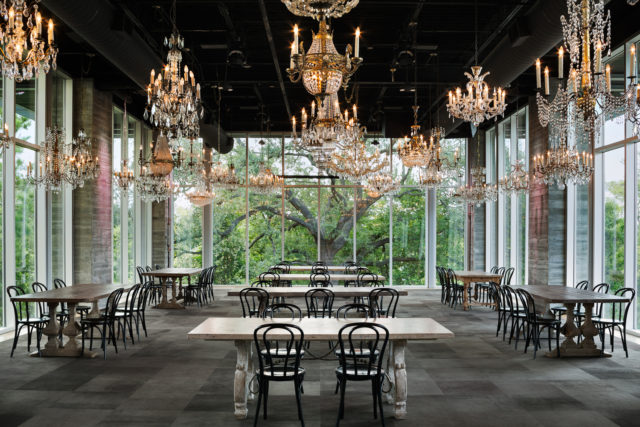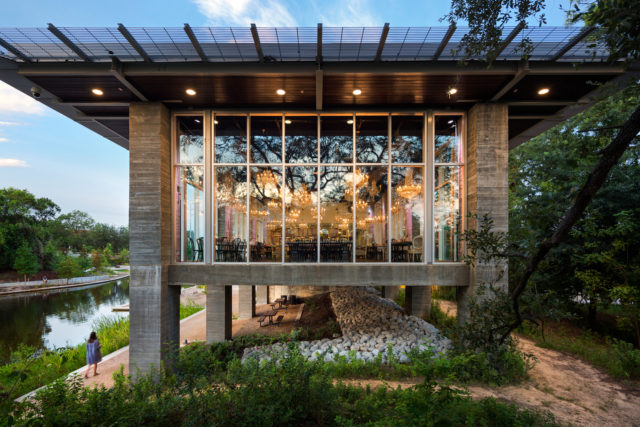In the Kitchen, patrons point their phones toward the bayou. Instead of Instagramming their meals, diners at the small restaurant in the Dunlavy train their cameras past the chandeliers to the sprawling live oak that envelops one of the restaurant’s fully glazed façades. The interior fades into the periphery and focus shifts to Buffalo Bayou Park. The reflected glare of the chandeliers is the only reminder of the shell at the edge of the building before the green patchwork of leaves and branches. But a turn of the head reveals open sky looking down on Lost Lake --- the re-created pond whose banks failed in the 1970s. Broad-shouldered highrises loom on the horizon.
These are the impressions of the Dunlavy. It delineates the border of bayou-side development. It is a perch through which to view Houston’s most iconic landscape --- a bayou box seat. It is a hovering mass behind the trees --- an eyebrow at the banks of the bayou. What you see depends on where you stand.
The Street
Allen Parkway is an undulating yet definitive edge of development. Cars hum around its curves and pass beneath rising concrete structures south of the Dunlavy. At the edge of the road, the topography drops, and recirculated water spills over tiered concrete pools leading to Lost Lake. Pedestrian pathways sweep down from the pavement. They travel along the pond until the road and cars disappear, leaving only the tops of buildings above the trees. Permeable pavers combine with asphalt, decomposed granite, and concrete. Decomposed granite was chosen to minimize impact on sensitive trees; asphalt matches the paths throughout the park. Owing its name to the closest cross street, the Dunlavy reads like a long capped wall, dividing the roadside and the lake from the bayou banks.
The building’s architectural vocabulary originates with the notion of resilience. It sits on heavy concrete columns of board-formed concrete, which lift its lowest beams 18 inches above the 100-year flood event. “We know the bayou is going to flood. It has to,” said Larry Speck, senior principal at Page, the architecture firm responsible for the Dunlavy. “Every decision had to do with making sure it could flood and the building not be damaged.”
High water was not the only hazard; the massive columns had to be able to resist the large rocks and even downed trees that can be swept along the bayou’s banks during major rain events. Between the columns, the building is clad with massaranduba, a durable South American hardwood. The building’s lower level is unconditioned, opaque storage, currently stocked with kayaks for rental and use along the bayou. The ends of the building transition to floor-to-ceiling glass, demarcating a visitor’s center at the southwest end and the Kitchen at the northeast.
The Kitchen
The interior is an eclectic play of contrasts. Victorian-inspired furniture and 43 chandeliers are set off against the base building’s site-responsive modernism. The black exposed ceiling, dark grey carpet tiles, and rustic wood table tops soak up the light. The glowing nodes of the chandeliers seem brighter. Yet the predominant impression is what’s behind the glass. Leaves and sky are the real finishes. Patrons are spectators.
The dual-concept restaurant was opened by Clark Cooper Concepts in late 2015 with breakfast and lunch service during the day and private events by night. “Our goal was to create a space that is elegant, yet simple,” said Grant Cooper, president and founder of Clark Cooper Concepts, who --- along with Jacy, his wife --- is responsible for the interior design. “We always wanted to have a restaurant with chandeliers to bring a relaxing, yet elegant feel that juxtaposes with the natural feel of Buffalo Bayou.”
A covered outdoor patio adjacent to the main dining area is nested within a grove of trees. It’s unexpectedly pleasant, even during rainstorms or summer heat. Operable shades and overhead fans regulate exposure and airflow. The shades, combined with outdoor heaters, make the patio comfortable during cold weather, according to Cooper. With the shades lowered, the landscape is a haze. The translucent roof is speckled with a series of small bulbs. The lamps seem to be frozen mid-swirl, cast off by the circulation of the blurred fan blades.
The Bayou
The bayou walkways weave along the banks. Some are caked with mud. In spots, there is the smell of stagnant water and the whine of mosquitoes. The silted waters are still beneath native oak, pine, sweetgum, cypress, and sycamore. There are glimpses of the Dunlavy through the leaves. The interior looks dark, and the striated grey concrete seems to have grown out of the strata of the bayou soil.
The Buffalo Bayou Partnership wanted to establish a small multipurpose facility at one of the only areas in the park that could be developed outside of the floodplain. The building is one of the few that has embraced the bayou, Houston’s driving feature of urban development and ecology. “It is difficult in Houston to find or develop settings for architecture with such a direct relationship to nature,” said Scott McCready, principal at SWA Group, the senior landscape designer on the project.
The integration of the Dunlavy with other park services has been successful, according to Buffalo Bayou President Anne Olson. Eventually the Kitchen is expected to offer more park-friendly options --- maybe picnic baskets with food, said Cooper --- so that the restaurant might serve as the beginning of a sequence of activities along the bayou. Kayak or bike rentals, boat tours, or visits to art and architectural draws like the Cistern. “Not everyone who is going to the Dunlavy is using the park. That’s one of the great things about it,” said Olson. “People are going to the Dunlavy to see what the park has to offer.”












